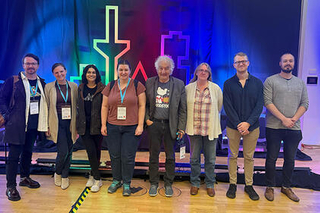Biographical Sketch:
Mesut Arslandok works in the ALICE collaboration at the Large Hadron Collider (LHC) at CERN with a joint Yale/CERN appointment. He has been involved in the ALICE experiment at CERN since 2010. His research covers many aspects of experimental heavy-ion physics such as detector physics and operation, software development, simulations and physics analysis.
Prior to coming to Yale, Mesut was a postdoctoral researcher at the University of Heidelberg.
He is a big fan of tennis, snooker and chess and also enjoys traveling and reading, in particular history and philosophy.
Research:
Mesut has served as the convener of the physics analysis group on even-by-event fluctuations since 2019, and has carried out several physics analyses in this field - such as conserved charge, net-proton and particle ratio fluctuations. These analyses are expected to shed light on the understanding of an extreme phase of matter - called the quark-gluon plasma (QGP) - created in high-energy heavy-ion collisions. This primordial state of matter is thought to have existed for the first few millionths of a second after the Big Bang. The QGP created in these collisions undergoes a transition to the hadronic phase, after it expands and cools down. Event-by-event fluctuations are very sensitive to this phase transition, therefore it also plays a significant role within the energy scan programs of the CERN SPS and RHIC.
As a member of the TPC (Time Projection Chamber) detector group, Mesut has been taking part in the operation of the TPC and working on the calibration and optimization of the TPC particle identification (PID) performance in both MWPC (Multi-Wire Proportional Chambers) and GEM (Gas Electron Multiplier) based technologies. He is also actively involved in the next-generation multi-purpose detector project at the LHC which is a follow-up to the present ALICE experiment (arXiv:1902.01211 [physics.ins-det]).
Education:
Ph.D., Goethe University, Frankfurt, 2017
Honors & Awards:
2025 Breakthrough Prize in Fundamental Physics (as part of the ALICE Collaboration)
Selected Publications:
- M. Arslandok and A. Rustamov, “TIdentity module for the reconstruction of the moments of multiplicity distributions”, Nucl. Instrum. A946 (2019) 162622.
- Y. Kalkan, M. Arslandok, R. Veenhof et al., “Cluster ions in gas-based detectors”, JINST 10 P07004 (2015).
- M. Bluhm, M. Nahrgang, A. Kalweit, M. Arslandok et al., “Dynamics of critical fluctuations: Theory–phenomenology–heavy-ion collisions”, Nucl. Phys. A1003, (2020) 122016.
- S. Acharya et al. (The ALICE Collaboration), “Global baryon number conservation encoded in net-proton fluctuations measured with ALICE at the CERN LHC”, PLB 807 (2020) 135564.
- S. Acharya et al. (The ALICE Collaboration), “Relative particle yield fluctuations in Pb–Pb collisions at √sNN=2.76TeV”, Eur. Phys. J. C79 (2019) 236
- INSPIRE publications


